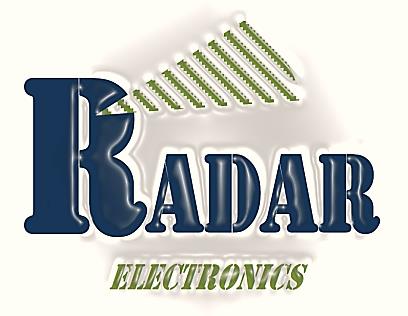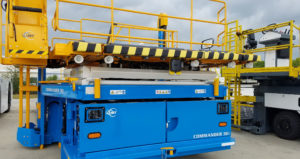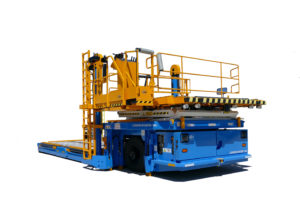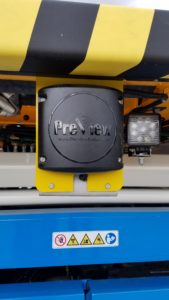Avoiding Costly Collisions Between Aircraft and Ground Equipment – JBT Corporation
Thousands of times every day in airports around the world, large pieces of equipment pull up to aircraft to provide a variety of services. JBT Corporation manufactures a wide scope of ground service equipment (GSE) including Cargo Loaders that load and unload cargo from the aircraft. If the loader operator does it correctly, it’s business as usual. If they collide with the airplane fuselage, operations can come to a complete halt, delaying takeoff times, costing airlines money, and frustrating passengers.
One of JBT Corp’s main objectives is make sure the equipment it manufactures never makes forceful contact with the aircraft it’s servicing. To do so, it relies on a suite of sensors, with PRECO’s Preview Radar serving as the first-line of defense against such collisions. When an airplane fuselage is struck forcefully, bad things happen. In older planes, punctures or dents in the aluminum body must be repaired to exacting specifications. In newer planes made of lighter and stronger composite bodies, special equipment must be brought to the airplane to test for potential, unseen damage to the composite structure. In either case, a collision between ground service equipment and the airplane fuselage is expensive and time consuming to repair which takes the aircraft out of service. It’s JBT’s job to make sure the equipment it manufactures mitigates the potential to make forceful contact with the aircraft it is servicing.
He is also responsible for JBT’s Halvorsen military loader. “Billions of dollars are spent every year repairing aircraft hit by ground support equipment,” Cecil says. “Cargo loaders come right up to the side of the aircraft so they have a high potential to cause damage. We install PRECO’s radar sensors on the loaders to detect when the equipment is nearing the plane’s fuselage. When the loader gets within a specified distance, it sends a signal to the loader’s operating system to slow the equipment down as it nears the plane.”
Working in Heavy Traffic Without False Positives
This might seem like an easy enough task to accomplish, but it is greatly complicated by the number of other ground service equipment operating near the aircraft. As they approach the plane, a JBT cargo loader must be aware of not only its proximity of the aircraft fuselage, but of countless pushback tractors, catering trucks, belt loaders, cargo trucks, loaders, fueling vehicles, lavatory vehicles, and people that dart around it. “When there are a lot of vehicles in close proximity of each other, the radar is always going to detect something,” Cecil explains, “so we have to work with individual airports and service providers to set up the warning systems on our loaders in such a way that they avoid a lot of false positive object detections.” In many cases, he says, customers set units up so the radar is active only when the operator platform on the front of the loader is in the elevated position. In this mode, the main focus is to avoid an aircraft strike. Since the loader is moving very slowly in this position, the operator can worry less about other objects nearby, but still must be alert to the changing conditions. Exactly how loaders behave around other objects on the tarmac is up to each airport and each company operating the loader. JBT maintains flexibility by designing a system that is configurable, enabling engineers to take input from the radar and use it to program how local entities want the loader to react. The radar is one of many sensors the loader’s operating system will use to react to situations on the tarmac.
Long- and Short-Distance Speed Control
"We typically adjust the radar to see five meters in front of the loader,” Cecil says. “These are fairly large vehicles, but they drive at typically slow speeds. We need the loader to see far enough ahead so that, if it senses an object, it has enough room to slow down even further to avoid approaching the fuselage with too much speed.” In the world of cargo loading, five meters is considered a long distance. When the radar senses an object five meters away (or whatever distance the customer designates), the loader’s operating system uses that information to enable the loader operator to approach at a safe and manageable speed. JBT loaders equipped with Aircraft Proximity Detection Systems automatically change speed control from a foot pedal to a hand throttle as the loader nears the fuselage. This change takes advantage of the fact that most people have finer dexterity and control with their hands than with their feet. As JBT loaders approach an aircraft, the task of avoiding a collision falls to short-range sensors mounted on the loaders. For these very short distances—less than one meter—the input from the sensor will signal the operating system to apply the brakes (auto braking) before the loader makes contact. In addition, touch-sensitive bumpers will bring the loader to a full stop if they are compressed against the fuselage. If the contact is too forceful, the bumpers can cause the loader to be locked in position until a supervisor can assess potential damage.
Adjusting Sensors to Accommodate Aircraft Design
JBT installs either one or two of PRECO’s sensors on each loader. One sensor is mounted in the center of the loader and looks straight ahead. For loaders that service very large planes, JBT will install a second sensor under the front of the operator’s console. Instead of aiming straight forward, this sensor is angled up at 5-10 degrees. This upward view is needed for larger aircraft whose tail sections sweep up away from the ground near the rear cargo door. By having one sensor looking up, the loader operator is better equipped to avoid contact with the portion of the fuselage that looms above.
Staying Relevant in a Fast-Changing World
Cecil points out that newer PRECO radars, which JBT is transitioning to, provide the ability to custom shape that pattern of radar waves emitted from the sensor. This ability to customize the detection zone allows JBT to improve its equipment’s ability to avoid costly aircraft collisions and further decrease false positives from other objects around the loader. “It’s been 11 or 12 years since we started really utilizing PRECO’s radars,” Cecil says. “Originally, it was because PRECO was one of the better technologies for sensing objects—particularly in harsh weather conditions. The new radars will give us more capability even as the sensor size shrinks. PRECO has increased performance and put it in a smaller package, which is a double win for us!” As with so many other forms of transportation, talk of autonomous ground service equipment is growing. “Automobile makers are developing new sensor technology at a very rapid and cost-effective rate,” Cecil explains. “The technologies and choices of sensors may change, but PRECO’s PreView Radar sensors were the right sensor when we first started installing them—and the way they’ve evolved makes them the right sensors today.”
Summary of Benefits:
- Consistent and reliable object detection to avoid damage to expensive aircrafts.
- Ability to intelligently integrate with JBT’s operating system and other installed sensors to slow loader down as it nears the aircraft.
- Customizable detection zones allow JBT to set a detection pattern as designated by their customers.


















